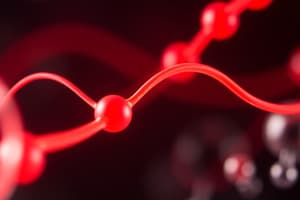Podcast
Questions and Answers
What term refers to an enzyme combined with a coenzyme?
What term refers to an enzyme combined with a coenzyme?
- Apoenzyme
- Cofactor
- Holoenzyme (correct)
- Prosthetic group
Which plot is used to determine enzyme kinetics and visualize the reciprocal of the reaction rate?
Which plot is used to determine enzyme kinetics and visualize the reciprocal of the reaction rate?
- Michaelis-Menten Plot
- Substrate Concentration Graph
- Enzyme Activity Curve
- Lineweaver-Burk Plot (correct)
Which factor does not influence the rate of enzyme activity?
Which factor does not influence the rate of enzyme activity?
- Substrate concentration
- Temperature
- Molecular weight of the enzyme (correct)
- pH
What do you call inhibitors that permanently inactivate their target enzymes?
What do you call inhibitors that permanently inactivate their target enzymes?
What effect does raising the temperature generally have on enzyme activity?
What effect does raising the temperature generally have on enzyme activity?
What is a coenzyme primarily used for in enzymatic reactions?
What is a coenzyme primarily used for in enzymatic reactions?
Which of the following statements is true about reversible inhibitors?
Which of the following statements is true about reversible inhibitors?
The Michaelis-Menten equation describes the relationship between which two variables?
The Michaelis-Menten equation describes the relationship between which two variables?
What is the term for the molecule that binds to the enzyme during a reaction?
What is the term for the molecule that binds to the enzyme during a reaction?
Which statement correctly describes the effect of temperature on enzyme activity?
Which statement correctly describes the effect of temperature on enzyme activity?
What does the Lineweaver-Burk plot help in determining?
What does the Lineweaver-Burk plot help in determining?
How does a competitive inhibitor affect enzyme activity?
How does a competitive inhibitor affect enzyme activity?
What happens to an enzyme when it is exposed to a denaturing agent?
What happens to an enzyme when it is exposed to a denaturing agent?
What is the mechanism by which competitive enzyme inhibitors function?
What is the mechanism by which competitive enzyme inhibitors function?
Which of the following describes a characteristic feature of non-competitive enzyme inhibitors?
Which of the following describes a characteristic feature of non-competitive enzyme inhibitors?
What does Vmax represent in Michaelis-Menten enzyme kinetics?
What does Vmax represent in Michaelis-Menten enzyme kinetics?
How is KM (Michaelis constant) typically interpreted in enzyme kinetics?
How is KM (Michaelis constant) typically interpreted in enzyme kinetics?
Which effect does the competitive inhibition have on the Lineweaver-Burk plot?
Which effect does the competitive inhibition have on the Lineweaver-Burk plot?
What is one consequence of enzyme inhibition by irreversible inhibitors, such as cyanide?
What is one consequence of enzyme inhibition by irreversible inhibitors, such as cyanide?
Which of the following factors is NOT essential for enzyme activity?
Which of the following factors is NOT essential for enzyme activity?
What effect does temperature generally have on enzyme activity within the optimal range?
What effect does temperature generally have on enzyme activity within the optimal range?
Flashcards are hidden until you start studying
Study Notes
Michaelis-Menten Kinetics
- Describes how enzymes influence a reaction's rate.
- The rate of an enzyme-catalyzed reaction depends on the enzyme's concentration and substrate concentration.
- The relationship between reaction velocity and substrate concentration can be described by a hyperbolic curve.
Kinetic Parameters
- Describes an enzyme's efficiency and binding affinity.
- Vmax: The maximum rate of an enzyme-catalyzed reaction.
- KM: A measure of how well an enzyme binds to its substrate. Related to the concentration of substrate needed to reach half of Vmax.
Lineweaver-Burk Plot
- A linear transformation of the Michaelis-Menten equation.
- Used to determine kinetic parameters (KM, Vmax) by plotting the reciprocal of velocity against the reciprocal of substrate concentration.
Effect of Temperature on Enzyme Activity
- Enzymes have an optimal temperature for activity.
- At low temperatures, the rate of molecular motion slows down, decreasing the enzyme's activity.
- At high temperatures, enzymes can denature, losing their shape and function.
Effect of pH on Enzyme Activity
- Each enzyme has an optimal pH range for activity.
- pH changes can disrupt the enzyme's structure and alter the ionization of the active site residues, affecting the enzyme's ability to bind its substrate.
Optimum pH Values
- Different enzymes have different optimal pH ranges.
- Trypsin: Functions optimally at a slightly alkaline pH (around pH 8).
- Pepsin: Functions optimally in acidic environments (around pH 2).
Effect of Substrate on Enzyme Activity
- Increasing substrate concentration initially increases the reaction rate until it reaches Vmax.
- At high substrate concentrations, all enzyme molecules are saturated with substrate, and the reaction rate plateaus.
Effect of Enzyme Concentration on Enzyme Activity
- The reaction rate is directly proportional to the enzyme concentration, as long as there is sufficient substrate available.
Cofactor
- A non-protein molecule that helps some enzymes function.
- Prosthetic groups: Tightly bound cofactors.
- Coenzymes: Loosely bound cofactors.
- Example: Nitrogenase: An enzyme that requires iron, molybdenum, and adenosine diphosphate (ADP) as cofactors.
Coenzymes
- Small organic molecules that can reversibly bind to enzymes.
- Transport chemical groups between different enzymes.
- Holoenzyme: An enzyme with its coenzyme.
- Apoenzyme: An enzyme without its coenzyme.
Enzyme Inhibition
- Substances that reduce or block the activity of enzymes.
- Irreversible inhibitors: Bind permanently to the enzyme, inactivating it.
- Reversible inhibitors: Bind temporarily to the enzyme. Can be categorized as competitive or non-competitive.
Competitive Enzyme Inhibitors
- Bind to the active site of the enzyme, competing with the substrate.
- Increasing substrate concentration can overcome competitive inhibition.
Non-Competitive Enzyme Inhibitors
- Bind to a site other than the active site, altering the enzyme's shape and reducing its activity.
- Increasing substrate concentration does not overcome non-competitive inhibition.
Impact on Health
- Enzyme inhibition can have toxic effects.
- Organophosphorus compounds (nerve gases): Irreversible inhibitors of acetylcholine esterase, leading to paralysis.
- Mercury containing compounds: Can inhibit various enzymes, leading to various health problems.
- Cyanide: An irreversible inhibitor of cytochrome c oxidase, disrupting cellular respiration.
Applications of Inhibitors
- Enzyme inhibitors have various applications in medicine, agriculture, and industry.
- Sulfa drugs: Inhibit bacterial synthesis of folic acid.
- Methotrexate: Used in cancer chemotherapy, inhibits DNA synthesis.
- Anticholinesterases: Inhibit acetylcholinesterase, used to treat myasthenia gravis and as insecticides.
- Allopurinol: Used for gout, inhibits xanthine oxidase.
- Disulfiram: Used to help people abstain from alcohol, inhibits aldehyde dehydrogenase.
Conclusion
- Enzymes are biological catalysts that accelerate chemical reactions by lowering the activation energy.
- Enzyme activity is influenced by factors such as temperature, pH, substrate concentration, enzyme concentration, cofactors, and inhibitors.
- The Michaelis-Menten model describes the relationship between enzyme activity and substrate concentration.
Studying That Suits You
Use AI to generate personalized quizzes and flashcards to suit your learning preferences.




